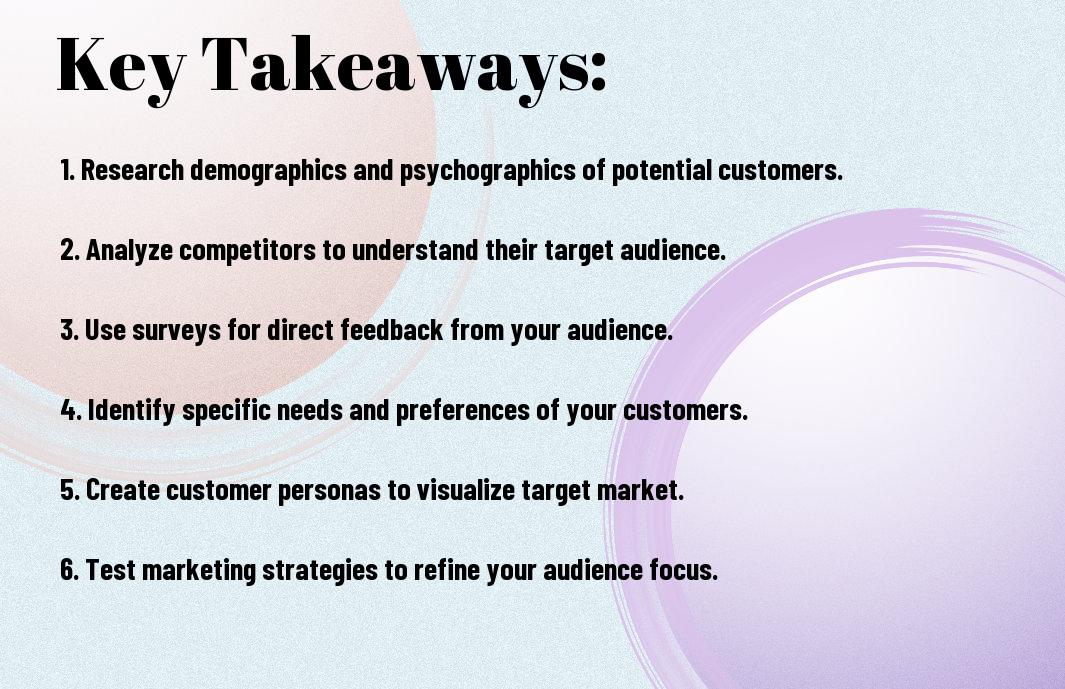Just understanding how to identify your target market can transform your business strategy and help you reach your audience effectively. By pinpointing the specific group of consumers most likely to buy your products or services, you can tailor your marketing efforts and enhance customer engagement. In this guide, you will learn practical steps to define and approach your target market, ensuring your marketing strategies resonate deeply with those who matter most. For further insights, check out this resource on How To Identify a Target Market (With Definition and Steps).
Key Takeaways:
- Demographics: Analyze age, gender, income level, education, and location to understand who your potential customers are.
- Psychographics: Explore interests, values, and lifestyles to gain insight into what drives your target audience’s purchasing decisions.
- Market Research: Utilize surveys, interviews, and focus groups to gather direct feedback from consumers and learn their needs and preferences.
- Competitor Analysis: Study your competitors to understand their target markets and identify any gaps or opportunities in the market.
- Customer Personas: Create detailed profiles that represent your ideal customers, including their goals, challenges, and preferred communication methods.


Understanding Market Segmentation
Before stepping into your target market, it’s imperative to grasp the concept of market segmentation. This involves dividing your broader audience into smaller, more defined categories to tailor your marketing strategies effectively. By focusing on specific segments, you can better meet your customers’ needs and enhance your product or service offerings.
Demographic Factors
Understanding demographic factors is vital for identifying your target market. These factors include age, gender, income, education, occupation, and location. Analyzing these characteristics helps you create a more precise marketing approach.
- Age groups, such as millennials or baby boomers
- Gender preferences
- Income levels
- Education and occupation fields
- Geographic regions
This approach allows you to tailor your messaging and product offerings to better resonate with your audience.
Psychographic Factors
On the other hand, psychographic factors pertain to your customers’ lifestyles, values, interests, and attitudes. By understanding these aspects, you can connect with your audience on a deeper emotional level, fostering stronger brand loyalty.
- Values and beliefs
- Hobbies and interests
- Lifestyle choices
- Personality traits
- Motivations for purchasing
After assessing these elements, you’ll gain insights on how to appeal to your potential customers effectively.
In addition to demographic factors, psychographic analysis provides deeper insights into who your audience really is. By evaluating their motivations, desires, and pain points, you can craft messages that resonate more effectively. Understanding psychographics can also aid in distinguishing your brand in a crowded market. Consider these factors for your strategy:
- Emotional drivers behind purchasing decisions
- Social status and community influence
- Changing trends and preferences
After conducting thorough psychographic research, you will refine your marketing strategy to appeal to your ideal customer segment.
Conducting Market Research
Now that you understand the importance of identifying your target market, it’s time to conduct market research. This process involves gathering and analyzing data about your potential customers to gain insights into their preferences, behaviors, and demographics. By utilizing various research methods, you’ll be able to pinpoint the characteristics that define your target audience, allowing you to tailor your marketing efforts effectively.
Surveys and Questionnaires
At the heart of effective market research are surveys and questionnaires. These tools enable you to collect direct feedback from your audience, helping you understand their needs and opinions. By crafting well-designed questions, you can gather qualitative and quantitative data that reveals insights into what drives your target market.
Focus Groups
After gathering data through surveys, consider organizing focus groups to dive deeper into your audience’s thoughts and feelings. This method provides a platform for open discussion, where you can observe the interactions and responses of participants in real-time. Focus groups can unveil valuable insights that quantitative data may not fully capture.
Another advantage of focus groups is the opportunity for dynamic interactions. Participants can bounce ideas off one another, which often leads to unexpected insights and perspectives. By moderating a discussion, you’ll gain a better understanding of how your target market perceives your product or service, as well as their emotions and motivations behind their preferences. This qualitative feedback can enhance your marketing strategies and product development efforts significantly.
Analyzing Competitors
Not only do you need to identify your target market, but you also need to understand how your competitors reach theirs. Analyzing their methods can provide insights into what works and what doesn’t. As you dive deeper, consider checking out these Steps To Identify Your Target Market to further inform your strategy.
Identifying Competitor Target Markets
Any analysis of competitors should start with identifying their target markets. Look into their customer demographics, preferences, and behaviors to pinpoint whom they’re trying to reach. By understanding the segments they focus on, you can better tailor your approach to meet those needs or find underserved audiences.
Evaluating Competitor Strategies
Besides identifying who your competitors are targeting, you should evaluate their strategies for engaging those markets. This involves looking at their marketing messages, channels, and content strategies to see how they attract and retain customers.
Due to the dynamic nature of marketing strategies, observing your competitors can provide a wealth of information. Take note of the social media platforms they use, the type of content they create, and the customer interactions they facilitate. Analyze their promotional tactics and customer engagement levels to uncover potential gaps in your own strategy. By understanding what resonates with their audience, you can refine your offerings and unique value propositions to differentiate yourself in the marketplace.
Creating Customer Personas
Keep in mind that crafting detailed customer personas can significantly enhance your marketing efforts. By developing these fictional representations of your ideal customers, you can tailor your products and services to meet their specific needs and preferences. This process not only helps you better understand your audience, but also allows you to create targeted messaging that resonates with them, ultimately driving engagement and conversions.
Defining Traits and Characteristics
For effective customer personas, you should define traits and characteristics that matter most to your potential customers. Consider aspects such as age, gender, income level, education, interests, behaviors, and lifestyle choices. By identifying these elements, you can create a well-rounded picture of who your customers are, which ensures your marketing strategies are relevant and impactful.
Mapping Customer Journeys
Along with developing customer personas, mapping customer journeys is an vital step in understanding how your audience interacts with your brand. This process involves analyzing the various touchpoints and experiences your customers encounter from the initial awareness stage to becoming loyal customers.
In fact, mapping customer journeys allows you to track your audience’s emotions, motivations, and pain points at each stage of their experience with your brand. This insight enables you to refine your marketing strategies, address potential obstacles, and create a seamless, enjoyable experience, ultimately leading to improved satisfaction and higher retention rates. By aligning your efforts with their journey, you position your brand as a solution to their needs, fostering loyalty and trust.
Testing Your Target Market
Many businesses overlook the importance of testing their target market before fully implementing their marketing strategies. By utilizing various techniques, you can gain critical insights into your audience’s preferences and behaviors. For detailed guidance on effective methods, check out How to Identify Your Target Audience.
A/B Testing Strategies
Beside demographic surveys, A/B testing allows you to compare two versions of a product or marketing campaign to determine which performs better. This method provides direct feedback from your audience, helping you make data-driven decisions about your offerings.
Refining Your Approach
For continuous improvement, it’s necessary to refine your approach based on the data gathered from your market tests. Adjust your messaging, product features, and marketing channels to better align with the expectations and needs of your target audience.
Strategies you employ should focus on iterative testing and feedback loops. This means regularly collecting data from customer interactions and using it to make incremental adjustments. Over time, these fine-tunings can significantly enhance your connections with your audience, leading to higher engagement and sales. Prioritize staying flexible and responsive, and continuously assess your findings to keep your marketing strategies relevant and effective.
Adjusting Your Marketing Strategy
Once again, fine-tuning your marketing strategy is important as you gain deeper insights into your target market. This adjustment allows you to effectively reach and engage your audience, ensuring that your messages resonate and drive desired actions. Adapting your approach based on research and market trends can lead to improved outcomes and a stronger brand presence.
Aligning Messaging with Target Market
Below, aligning your messaging with your target market involves creating content that speaks directly to their needs and preferences. By understanding your audience’s pain points, values, and interests, you can craft tailored messages that engage them more effectively and foster a positive connection with your brand.
Utilizing Feedback for Continuous Improvement
By consistently seeking and analyzing feedback, you can enhance your marketing efforts over time. Engaging with your customers allows you to gather valuable insights that inform your strategy, ensuring that your messaging and tactics remain relevant to their evolving needs.
The feedback loop is an ongoing process of learning and adapting. By actively encouraging customers to share their thoughts, whether through surveys, reviews, or direct conversations, you can identify what’s working and what requires adjustment. This information not only helps you to refine your messaging but also demonstrates that you value your customers’ opinions, fostering loyalty and trust in your brand.
Summing up
With this in mind, identifying your target market involves thorough research and analysis of your audience’s demographics, behaviors, and needs. By understanding who your potential customers are and what drives their purchasing decisions, you can tailor your marketing strategies effectively. Utilize surveys, social media insights, and market trends to refine your approach and connect with your ideal audience. This targeted focus will not only enhance your marketing efforts but also foster stronger customer relationships, driving your business toward long-term success.
FAQ
Q: What is target market identification and why is it important?
A: Target market identification refers to the process of defining and understanding the specific group of consumers who are most likely to purchase your product or service. Identifying your target market is important because it allows you to tailor your marketing efforts to meet the specific needs, preferences, and behaviors of that group, leading to more effective communication, higher conversion rates, and ultimately, increased sales. By focusing on a defined audience, businesses can optimize budgets and resources for maximum impact.
Q: What methods can I use to identify my target market?
A: There are several methods to identify your target market, including: conducting surveys and interviews to gather direct feedback from potential customers, analyzing your existing customer data to find common characteristics, utilizing market research reports to understand industry trends, and engaging in social media listening to gain insights about consumer interests and preferences. Additionally, creating buyer personas, which are detailed profiles of your ideal customers, can help clarify who you are trying to reach.
Q: How can demographic and psychographic data help in target market identification?
A: Demographic data, such as age, gender, income level, and education, provides a foundational understanding of who your potential customers are. Psychographic data, on the other hand, dives deeper into the values, interests, lifestyles, and motivations of consumers. Combining both types of data allows businesses to create a more comprehensive picture of their target market, leading to more personalized marketing strategies. By understanding both who your customers are and what drives their decisions, you can effectively tailor your products, services, and messaging to resonate with them.


